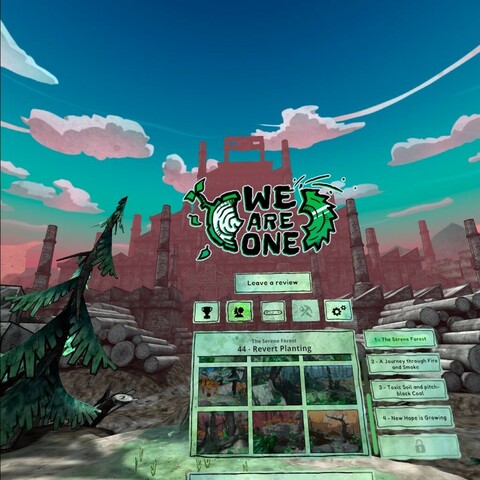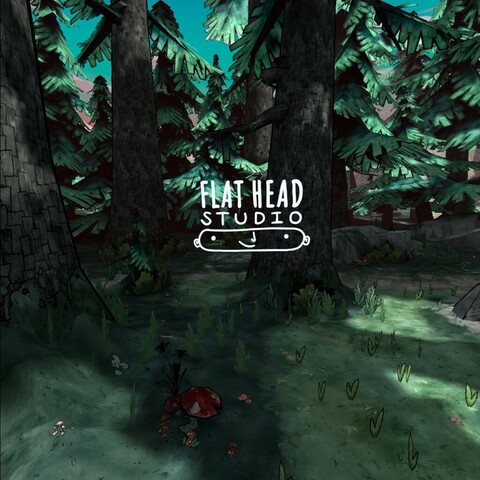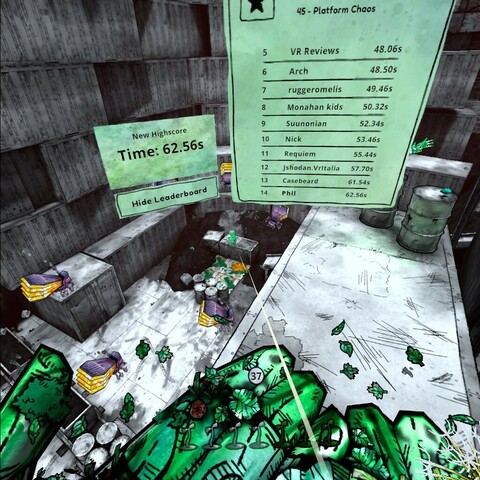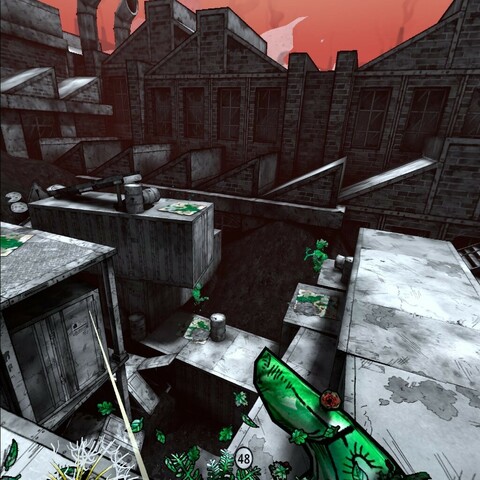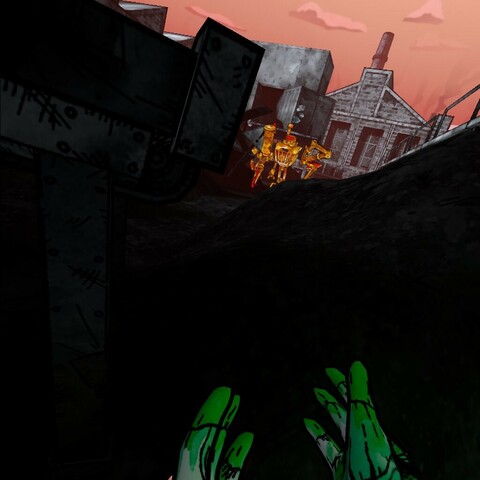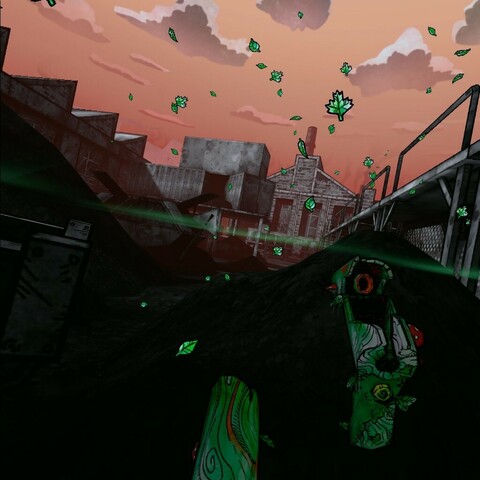We Are One – Reviewed On Meta Quest 2
When I set out to play We Are One I was quickly reminded of the myriad reasons why the Meta Quest 2 – which has somehow managed to lurk, forgotten in a box for the last few months – struggles to gain much attention in our household. Despite some thoroughly excellent games, some of which could only ever exist within the unique framework of VR, the sheer inconvenience of the device remains a roadblock to casual use.
This is unfortunate because despite the many flaws, caveats and general nuisances of VR games like We Are One are thoroughly enjoyable. At least until an accidental wall punch, spilled coffee or other disaster sees you tumbling out of its immersive, mind-twisting world. Yes, these things and more happened as I tried to quietly review We Are One in my toddler’s bedroom after getting everyone settled for the night. A bedroom, I might add, that has ample if enviable floor space and shockingly little clutter. A space that still proved to be inadequate for the ducking, weaving and flailing you’ll need to master We Are One’s frenetic control-all-your-clones mechanic that might have inspired The Last Clockwinder.
Mostly sharing these because I need a cover image, but they do show how bright and vibrant the game can be. There’s a clear juxtaposition between the leafy green woods and the industrial wasteland. This tonal shift is relevant to the plot which is slowly delivered via spoken exposition as the game progresses.
We Are One started out life as far back as 2020, available on SideQuest VR – a side-loading app store for the Meta Quest – as “Help Yourself”. While it started small, it was a hit with SideQuest users, blowing minds and garnering five star reviews. How has it shaped up in the three years since? As far as I can tell things haven’t changed dramatically, the core concept remains, as does some of the art style, but the game has been polished up with a more cohesive style and narrative to root the mechanics into something resembling an action puzzle adventure. The game was renamed from Help Yourself to We Are One in February 2022, by means of a Discord poll, but remains effectively the same concept, if vastly improved upon from its rough origins.
One YouTuber at the time puts it more eloquently than I could muster here (https://www.youtube.com/watch?v=pxIl71vjb7k)- “Do you like teamwork, but hate other people?” And that’s exactly what We Are One delivers. An unmistakably team-based cooperative game where you play the whole team, simultaneously, using time loops, lateral thinking, memory, coordination and sometimes more than a little trial and error.
The fanfare and official store release of We Are One is well deserved. It’s an excellent concept that will, no doubt, get mistaken for a derivative of The Last Clockwinder. It’s based fundamentally around combat, defending your forest kin from an onslaught of menacing machines in a tale as old as time, but which always evokes memories of 1992’s Fern Gulley.
I’ve been playing We Are One, a shiny new release on the Oculus/Meta store that started out life as a rough and unpolished, but very well received, SideQuest game. It’s effectively a co-op puzzle shooter except you play every single character yourself. Well, mostly, the puzzles are varied and they explore the concept in depth with some interesting and oft challenging results. Grab it- https://www.oculus.com/appreferrals/gadgetoid/4052099231581371/?utm_source=4 (referral link)
You start each level with a god-like overview atop a giant of plant-like hands. This vantage point shows the locations you’re able to spawn, where the enemies are and – crucially – how your time-looping solution plays out. You can spawn copies of yourself- called Sproutlings in different fixed locations, one at a time. The challenge, then, is to spawn in each location and perform a set of actions that will- when put together- coordinate with every other location to eliminate all of the enemies on the level. You are effectively time-looping, playing each character in turn while your previous actions – recorded by the game – are played out alongside you. Throw a gun into empty air, spawn a new version of yourself, catch it, shoot the enemy.
While there’s plenty of shooting involved, We Are One doesn’t let you simply shoot everything. That would be too easy. You’ll find yourself having to reflect enemy shots, bounce your own shots off walls, bounce your own shots off future versions of yourself, coordinate multiple parallel versions of yourself to shoot multiple enemies simultaneously, carefully throw grenades to hit enemies and more. When you do fall back to plain gunplay it’s still heavily confounded by having to divide targets among the multiple versions of yourself, and remember who shot (or will shoot?) who. The game might start simple enough, but is intent to never be straight-forward. You’ll even encounter unplayable copies of yourself with predefined actions you’ll have to play along with – or thwart.
Many levels can be exploited with careful abuse of VR position tracking. If you have the height or the room space you can often reach over or learn around obstacles to make a mockery of We Are One’s carefully crafted puzzles. I’ve done this a few times- if you give me an inch I’ll take a mile- which is probably why I managed to hit walls and spill coffee.
Perhaps an unintentional side effect, but the freedom of VR meant I spent a lot of time lying prone on the floor in order to lazily avoid enemy projectiles (flying cutting discs because they’re logging robots I guess!) while I waited for a past self to toss me a leafy shooty bang bang.
In some other cases the VR setup can be frustrating. Often it’s a fumble to load a gun in a hurry, especially if you’re trying to hold one and shoot while loading another, or fumble around to grab something off the floor that you failed to catch. Since you can reach far beyond your actual grasp to pick up objects (an essential accommodation without which the game would be extremely difficult) it’s often up to the game to guess what you’re reaching for, and this sometimes gets fiddly. Conversely I’ve thrown guns and ammo through the air at each other and had a gun load itself in mid-air, a quirk that a gamer more skilled than I will no-doubt exploit to devastating effect.
Visually We Are One is near perfect. It leans into a cel-shaded style with a low polygon count that works well to keep the levels readable and uncluttered. Environments trend slowly from woodland to industrial hellscape to keep things fresh. The floating anthropomorphic plant character models are a little disconnected from the environment, but they brush the difficulty of animating legs or roots or stems or … something … neatly under the rug in favour of just doubling down on what makes the game good.
Little mechanical flourishes such as enemy projectiles shooting the gun out of your hand are very cool and the physics-based throwing and passing of weapons and items- later augmented by a slingshot- leaves plenty of opportunity for… creative puzzle solving.
The story is delivered at the start of puzzles via spoken exposition and isn’t really a central part of the game, though it does help tie the puzzles together and help make everything make sense.
Unlike its early iterations We Are One now has an ample supply of puzzles with lots of opportunity to master the mechanics and replay earlier levels for a better completion time. There is an extremely high skill ceiling with plenty of opportunity for perfection of your aiming, throwing, dodging, bouncing and coordination skills if you’re a completionist or speedrunner. The game leans into this by providing a Leaderboard so you can effectively set your own difficulty by how competitive you’re feeling. Some levels have very obvious long solutions, and mechanically difficult shorthand solutions. I know this because I ended up taking the long route, only to have the Leaderboard utterly embarrass my efforts.
Overall this is exactly the sort of experience that VR really works for and if you’ve got a Quest 2, the space, the time and a thirst for a mind-bending puzzle shooter then it’s well worth a look. The rave reviews of We Are One in its formative “Help Yourself” state were well deserved, and it’s clear to see all the feedback and effort that’s gone into pulling together this game from a rough and ready concept into the cohesive whole that it is today.
If you want to grab the game and throw me a bone, you can use this referral link: https://www.oculus.com/appreferrals/gadgetoid/4052099231581371/?utm_source=4
